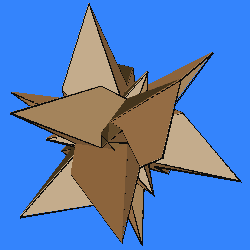Tetrahedral Stellations of the Icosahedron
 There
are 59 well-known stellations
of the icosahedron which have full icosahedral symmetry. This page
considers what happens when one relaxes the symmetry requirements and we
look for fully-supported stellations of the icosahedron which have only
tetrahedral symmetry. This is analogous to the case of tetrahedral
stellations of the dodecahedron, but while there are only a dozen of
those, we find several thousand of these. Given the large number, I have
chosen a random sampling here, in no particular order, to illustrate the
variety of forms. It is interesting to see pieces of the familiar 59 stellations
arranged in different places. Most are chiral but some have three mirror
planes.
There
are 59 well-known stellations
of the icosahedron which have full icosahedral symmetry. This page
considers what happens when one relaxes the symmetry requirements and we
look for fully-supported stellations of the icosahedron which have only
tetrahedral symmetry. This is analogous to the case of tetrahedral
stellations of the dodecahedron, but while there are only a dozen of
those, we find several thousand of these. Given the large number, I have
chosen a random sampling here, in no particular order, to illustrate the
variety of forms. It is interesting to see pieces of the familiar 59 stellations
arranged in different places. Most are chiral but some have three mirror
planes.
Many of these appear somewhat otherworldly, in that one sees immediately that there is some structure present, but it takes a few moments to really appreciate what the structure is. To me, that is part of the beauty of tetrahedral symmetry, that different aspects of the structure can be revealed as it is turned around, and only continued exploration reveals all the connections.
- 1. (4 octahedra from the compound of 5 octahedra)
- 2.
- 3.
- 4.
- 5.
- 6.
- 7.
- 8.
- 9.
- 10.
- 11.
- 12.
- 13.
- 14.
- 15.
- 16.
- 17.
- 18.
- 19.
- 20.
- 21.
- 22.
- 23.
- 24.
- 25.
- 26.
- 27.
- 28.
- 29.
- 30.
- 31.
- 32.
To appreciate their symmetry, be sure and find their four 3-fold axes and six 2-fold axes; note that the two opposite ends of each 3-fold axis are different. In each stellation, the faces come in three shapes: four of one shape centered on a 3-fold axis; four of a second shape, opposed to the first four; and twelve of a third shape. If the stellation has three mirror planes, the third shape (of which there are 12 faces) is mirror symmetric, and the first shape will be the mirror of the second shape
There is no published reference to these. I have just created them with a general-purpose stellation program I have written, which generates many kinds of stellations of all kinds of polyhedra. An interesting relative to these (but which has only 16 sides) is the tetrahedrally stellated icosahedron.
Virtual Polyhedra, (c) 1996,George W. Hart